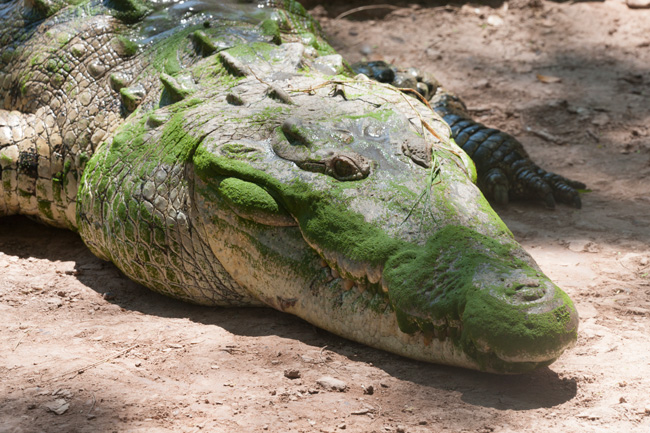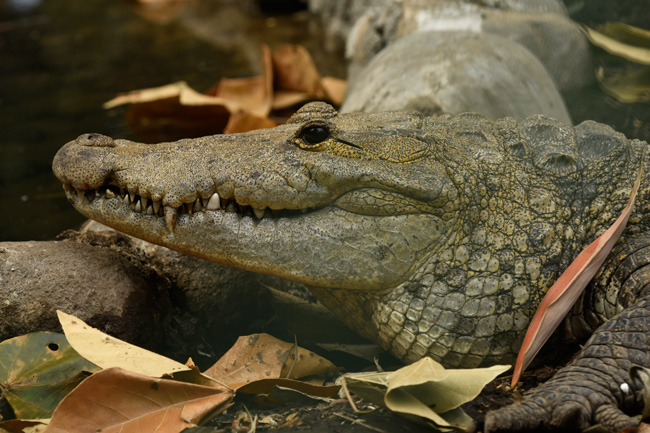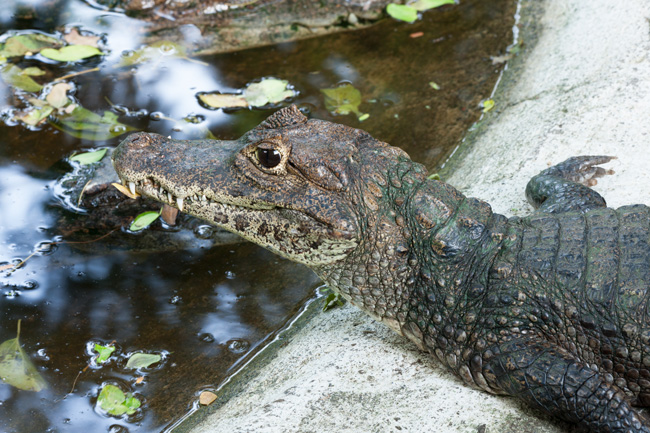During the 1970’s through 1980’s I worked on my PhD dissertation on plants and animals of the Surface of the Underwaterworld, a major component of Maya cosmovision. Crocodiles and/or alligator-caimans were a common creature in this symbolic cosmology.
Plus I have lived and worked at Tikal in 1965 where there have long been crocodilians in the aguada. And I lived and worked five seasons to create the Parque Nacional Yaxha-Sacnab, where there are plenty of crocodilians in both lakes.
During the last five years we have frequently visited CECON, the caiman raising center in Monterrico, on the Pacific coast. So we at FLAAR Reports have a fairly good background in crocodilians (a caiman is more of an alligator despite its scientific name Caiman crocodylus), despite having an original background in traditional dirt archaeology (Guatemala and two seasons in Peru, while a student at Harvard).
My earlier exposure to crocodiles in Maya iconography
The first time I would have seen a crocodile or caiman in Maya art would have been on the stela at Copan, at least by 1967, when I was about 17-18 years old, and already on my second field trip to the Maya area. By that same year I had already been a student on an archaeological expedition (with INAH to Bonampak).
My interest in crocodiles and alligators of the Maya area comes from having visited Izapa, the Preclassic Maya ruins in Chiapas, Mexico, near the border with Guatemala. There are several Izapa stelae which have a “crocodile tree.” I have also visited the archaeology museums of Chiapas and the Museo Nacional de Antropologia, where more of the Izapa stelae are located.
The New World Archaeological Foundation has done a helpful job of publishing their first-generation basic line drawings of the stelae. However today a lot more is known about the trees which grow out of the bodies of these crocodilians. I can readily provide a full botanical identification of one of these trees. And I can provide a pretty good identification of the others.
If I understand correctly, new and improved line drawings of some of the stelae are also available from NWAF, but I do not have these at hand.
Most of the identifications of the Izapa stelae trees in the traditional literature are incorrect because each author cites the previous author. Not too many Maya scholars have gone out to the swamps and studied the actual creatures (or the actual trees) in vivo. Of course seeing crocodiles on the river shores and lakes is not realistic way to studying them. The crocs jump into the water before you can get close.
The best way to study them is in zoos or private preserves. One of the biologists who works at FLAAR, Ilena, recently went to Honduras to inspect a crocodile preserve which I had read about in a Guatemala City newspaper. So we now have an initial web page on this preserve. The preserve claims to have “10,000 crocodiles.” All are Crocodylus acutus, the American crocodile, a denizen of the Maya area. We visited this crocodile farm in late September 2013. The staff were hospitable and helpful.
As you notice, we work hard to harvest information from zoology and botanical field trips so that archaeologists, iconographers, ethnographers and epigraphers of Mayan linguistic groups have fresh information, and more high-res photographs than are in the standard textbooks.
With the current financial crisis around the world it is not realistic for Mayan iconographers to get from their home universities down to CECON or to the middle of Honduras. We at FLAAR try to do this on our own so that our photographs and notes can assist scholars, students, and interested lay people all around the world can obtain documentation directly at their desk, at home or at work.
Our long range goal is to provide tabulations to assist iconographers to understand which creature on a Maya stela is which species out in the rain forest, river, or coastal mangrove swamp. Frankly “most crocodiles look similar” at first glance. And, even when you recognize the differences, it is a challenge to remember which crocodile has which Latin scientific name. Keep in mind we are working on over 300 different species of reptile, insect, bird, feline as well as close to 400 species of plants. I can pretty easily recognize the difference between a Ceiba pentandra and a Ceiba aesculifolia, and spell them both from memory, but I am not yet able to remember all the pito species or the Zanthoxylum species (nor can I write their Latin botanical names without using references).
The main issue, however, is that most representations of crocodiles in Classic Maya art are relatively generic. You can’t always see enough specific features to be able to recognize which species was intended. A mouth may simply have “lots of teeth and plenty of fangs.” And this mouth may be a composite of serpent fangs and crocodilian fangs. When the artist added features of a venomous centipede it becomes even more difficult. We are working on centipedes but the species of interest to Maya artists are a challenge to find out in the wild. Crocodiles are relatively easy.
To assist Maya researchers we are working at providing tabulations. We have the tabulation on “where to find each species in a zoo” finished. In some cases we can at least indicate the name and location of the zoo, but it will take a while to identify which species are present.
We need to do further research before we can handle the tabulation on crocodilian head details. But let’s start with where to find each species in Mesoamerica.
|
|
Countries |
Coastal areas |
Inland Rivers, lakes |
|---|---|---|---|
| Crocodylus acutus |
Belize; Colombia; Costa Rica; Cuba; Dominican Republic; Ecuador; El Salvador; Guatemala; Haiti; Honduras; Jamaica; Mexico; Nicaragua; Panama; Peru; United States (Florida); Venezuela |
In the Atlantic from the southern tip of Florida and the Caribbean islands of Cuba, Jamaica and Hispaniola to the Yucatan of Mexico and south to Colombia and Venezuela. Along the Pacific coast it is found from Northern Sinaloa in Mexico to the limits of mangrove coastal habitats in northern Peru |
An isolated subpopulation is found in the Rio Grijalva basin in Mexico. |
|
Crocodylus moreletti |
Belize; Guatemala; Mexico |
This species is distributed from northeastern Mexico's central Tamaulipas area, through the Yucatan Peninsula to northern Guatemala and central Belize. |
|
|
Caiman crocodilus |
Brazil, Colombia, Costa Rica, Ecuador, El Salvador, French Guiana, Guatemala, Guyana, Honduras, Mexico, Nicaragua, Panama, Peru, Suriname, Trinidad, Tobago, and Venezuela. |
Can tolerate a reasonable degree of salinity. |
The extensive Panatal floodplain provides a perfect habitat for the caiman during the rainy season. |
|
Habitat: where can you find each species |
|---|
Where to study crocodiles in Mesoamerica
CECON is associated with USAC. The people at CECON have always been hospitable. In return, and in exchange, FLAAR provides services for them at no cost. For example, we do professional quality, high-res digital photography for CECON (and donate the photographs to their educational programs).
Auto Safari Chapin is owned by a well known family in Guatemala. The head of Auto Safari Chapin has always provided the FLAAR teams access inside any pen or area which we wish (though they wisely suggested we not try to enter any peccary pen).
The crocodile farm in Honduras was really considerate of our research goals recently (September 2013). They allowed us inside an area with 50 giant adult crocodiles and I was able to lay down on the ground within 2 meters of the crocs so that I could take photographs of their jaws. This position is because the Classic Maya show the jaws in profile. If we want to know which species the Maya artist is rendering, we need to study the pattern of teeth in each species.
The Aurora Zoo (and in part Auto Safari Chapin) was initiated with the help of Ricardo Mata. He was Guatemala’s most popular and talented professional photographer for decades. Since his brother (Dr Guillermo Mata, first president of Museo Popol Vuh, and one of the founders of Universidad del Istmo) was my dentist we got to know Dickie Mata decades ago.
Although Ricardo Mata has passed away, the new administration of La Aurora Zoo really have been considerate and helpful. In return we provide them with a class of high res photographs that can assist in their programs.
We have never photographed in the Belize Zoo, but if they have at least two species they could be worth visiting; we list them since many Mayanists may be working in Belize and can consider this zoo. Several people have told us they charge a fee for doing photography; since we do not earn any profit from our studies of crocodiles, we have no budget to pay in order to do research (since our research provides plenty of PR for the institution where we do the photography).
ZOOMAT personnel were very helpful and cooperative when I photographed there several times in the 1970’s and 1980’s. However since it is a pain to cross back and forth across the border with all our equipment, we tend not to drive as far as deep into Chiapas. It is easier to drive to Petencito for Moreletti.
Several people have mentioned a “crocodile farm” in the Costa Sur area of Guatemala, but we do not know where they are located, so have not visited this place.
|
|
Crocodylus acutus |
Crocodylus moreletti |
Caiman crocodilus |
|---|---|---|---|
| Belize zoo, Belmopan |
|
|
|
|
ZOOMAT, Tuxtla Gutierrez, Chiapas |
|
|
|
|
La Aurora Zoo, Guatemala City |
|
|
|
|
CECON, Monterrico |
|
|
|
|
Auto Safari Chapin Costa Sur, Guatemala |
|
|
|
|
Clan Continental, Honduras crocodile raising farm |
“10,000” of this species; only this species |
|
|
|
we hope this tabulation makes your field trip planning easier
|
|---|
You can still see crocodilians along the Rio de la Pasion. I can remember seeing crocodilians along the Rio Usumacinta in the 1980’s. There are still crocodilians along the Arroyo Petexbatun out of Sayaxche, El Peten. And I estimate there are plenty in Lake Yaxha and Lake Sacnab.
But as an iconographer, to study them along the shore, unless you simply want to enjoy the river trips, is a horrendous waste of time and research funds. Most of the creatures are small and you will never get close enough to get good photographs or to study their scale pattern. Studying the animals in a zoo, or a private collection, is more realistic, although perhaps a bit less exciting.
If you wish the exciting portion, ask for permission to be allowed into the cages, so you can study the reptiles up close. Just realize that even if the zookeeper is next to you, there is no way for anyone to stop the charge of an irritated crocodile or caiman.
I had a pet crocodile for several years (it had been speared by a Petenero and I rescued it, had it treated first by a medical doctor, then I took it to a vet in Guatemala City, and then I raised it back to health (in my office), at which point I donated it to La Aurora Zoo (it bit too many of our house guests when they tried to pet it, assuming that since it was free to wander around my office that it was like a house cat or dog).
At FLAAR we do not use cages for any of the animals which happen to end up in our facilities. And yes, we do understand that crocodiles are supposed to be left in their natural habitat, but the crocodile we found had a gig (three-pronged spear) through its body and was on its last gasp (local people use them for target practice even when not large enough to sell for their hides).
After giving it emergency medical care, we flew it back on an airplane to an animal hospital (in Guatemala City, we never take any creature out of the country). Naturally the crocodile was not accustomed to being in a carry-on-bag on an airplane, so once the plane took off the crocodile decided to wander around the plane (looking for the toilet perhaps?). So it crawled under all the seats.
But this was before there were any rules on local Peten airlines and no one seemed to worry about it.
Being interested in plants and animals my entire life I have had many such entertaining experiences.
Characteristics important in the identification of crocodilians
|
Species |
Size |
Teeth position |
head shape |
Figure | |
|---|---|---|---|---|---|
| Crocodylus Acatus |
|
|
|
|
|
|
Crocodylus Moreletti |
|
|
Snout relatively broad, length about 1.5 times width.
|
|
|
|
Caiman Crocodilus |
|
|
|
|
 |
|
Fig. 1 Crocodylus acatus or American Crododile
|
 |
|
Fig. 2 Crocodylus moreletti or Morlet's crododile
|
 |
|
Fig 3. Caiman Crocodiles or Spectacled Caiman
|
We are not currently doing a project on snails, but we can at least mention one useful article. In its bibliography you can find more.
Bibliography on Crocodiles: References for drawings and distribution data.
- The bibliography is on our sister web site (our bibliography web site), www.maya-art-books.org
The next step in our research will be to develop tabulations of features selected by Nicholas Hellmuth to aid iconographers and art historians. We are working on filling out these tables for dentition, supraorbital plate structure, nose position, and other details that the Maya feature in their renditions.
We need a few more photographs and then we need our own line drawings since not all line drawings in the literature are accurate enough. As soon as we have all the information we will produce a full-color PDF.
We apologize that it is a bit slow, but the economic situation around the world means that funds are not available for the zoological illustrators that we need.
First posted October 2013































